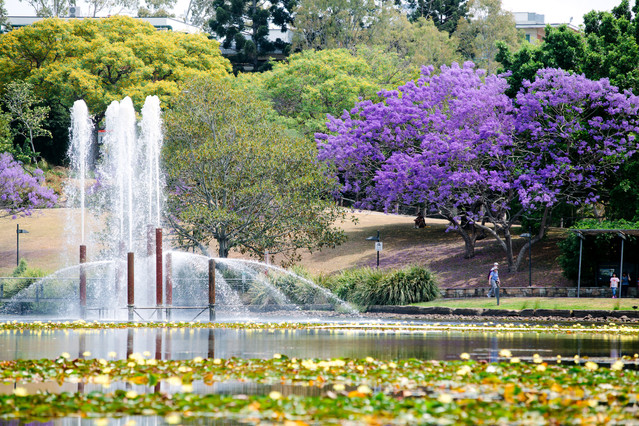A deep dive into UQ Lakes
 UQ’s St Lucia Lakes have long been an iconic feature of the University grounds. They’re more than
UQ’s St Lucia Lakes have long been an iconic feature of the University grounds. They’re more than
just a pretty face on campus — they irrigate the Great Court, St Lucia grounds and sporting fields, and are home to numerous native species of flora and fauna.
So what’s the story behind this beloved waterway, and what plans are in store for its future?
The original, freshwater St Lucia Lake is well over 60 years old: it was created in the late 1940s or early 1950s by damming the flow path of Carmody Creek. In the 1980s, it was joined by the Effluent Lakes, which were constructed in collaboration with Indooroopilly Golf Club and Brisbane City Council, and
that now receive Grade A recycled water from Fairfield Sewage Treatment Plant.
The freshwater lake is a true aquatic ecosystem: there’s life to be found above and below the surface, including mammals, reptiles, fish, insects, over 60 bird species, microflora, plants and weeds. In 2015, UQ’s riverbank restoration project — undertaken in partnership with the Society for Conservation Biology Brisbane Chapter and funded by the Queensland Government — improved biodiversity on campus by creating a wildlife corridor linking the vegetation along the Brisbane River upstream of the campus with the UQ Lakes area.
Water quality samples have been taken regularly in the freshwater lake since 2010, and from the effluent lakes since 1999, to monitor nutrients, E.coli and algae counts and to maintain the precinct’s ecological balance.
Topping it all off (literally) is the fountain, which plays both a practical and an aesthetic role. The old fibreglass fountain was donated by benefactors Victor and Evelyn Lewis around 50 years ago, and was designed to create visual interest. While the original fountain was retired in 2012, a replica was installed the same year. As well as adding dramatic flair to the area, it also aerates the lakes and provides a refuge for aquatic life during hot weather — thermal images show that the water in the vicinity of the fountain is cooler.
But all isn’t always calm beneath the surface of our lakes. It can be challenging to maintain healthy ecosystems for urban lakes, since they’re very different from self-sustaining natural lake systems and can be subject to changes over time. For example, while our lakes can receive and store stormwater flows, the original lake was not designed to receive untreated stormwater and associated build-up of sediments and nutrients.
Urban lakes that aren’t managed properly can suffer from poor water quality and aquatic weed infestations. Certain climate conditions can also have adverse consequences: earlier this year, Brisbane’s dry, hot weather led to algal blooms that turned our lakes a striking shade of green.While algal blooms are a common occurrence in South East Queensland’s freshwater lakes, they can have detrimental effects on long-term lake health — and climate change is increasing their risk of recurrence. In an effort to combat this problem at UQ, the University’s Property and Facilities division has established a new St Lucia Lakes Management Working Group that’s on the case to ensure our lakes’ survival for future staff, students and visitors.
After engaging the International River Foundation to review UQ’s current water-quality monitoring program and prevent future algal blooms, the Working Group is developing long-term lakes management options. These include identifying ways to improve the condition of the lakes, through de-silting the lake, improved stormwater treatment, undertaking more regular water monitoring and making Lakes data readily available online.
In keeping with the aesthetic value of the lakes precinct, there are also plans to install more shaded seating in the area in the near future.
Looking after our Lakes doesn’t just mean we’re preserving the beauty of our campus. We’re also preserving an invaluable learning resource for UQ students: urban hydrology students are currently using the Lakes as a case study, and their research will help inform the efforts of the Working Group.
While the Working Group will initially focus on the St Lucia Lakes, they’ll eventually broaden their scope to include other lakes across the UQ estate, including those at Gatton and Pinjarra Hills. All these urban waterways are essential to UQ operations, and their effective management will ensure their future health and viability
